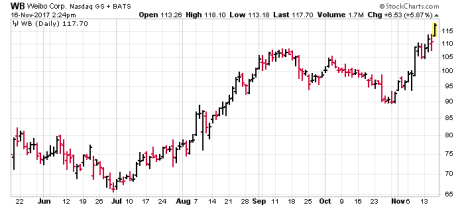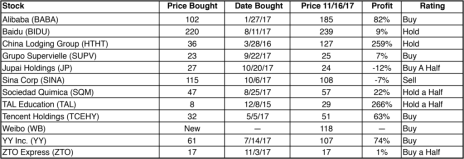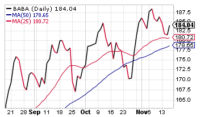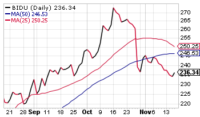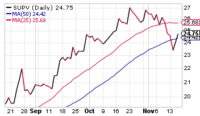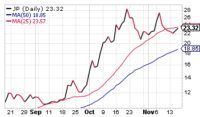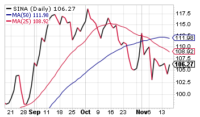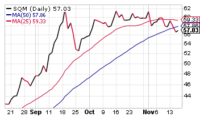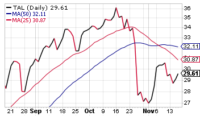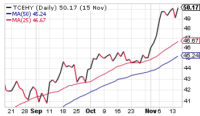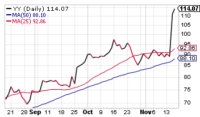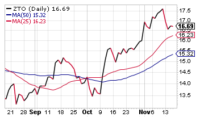There has been plenty of action in emerging markets recently, but today’s strong rally pushed the Cabot Emerging Markets Timer to a clear buy signal. Part of this may be the continuing effect of a great Singles’ Day splurge in China, and I write about that. We’re making some adjustments to the portfolio to put the spotlight on the winners and switch out of one laggard.
Cabot Emerging Markets Investor 646
[premium_html_toc post_id="141484"]
Cabot Emerging Markets Timer
The Emerging Markets Timer is our disciplined method for staying on the right side of the emerging markets. The Timer is bullish when the index is above the lower of its two moving averages and that moving average is trending up.
Our Emerging Markets Timer is still positive, but the next few days should tell us a lot about the uptrend. The first thing to notice about the chart above is that the iShares EM Fund (EEM) has been mostly chopping around during the past two months, with no net progress since mid-September. Moreover, the recent dip has brought the stock down to its lower (50-day) line.
That said, our methodology is to always go with the evidence in front of us—and today, that means the intermediate-term trend of emerging market stocks is pointed up, and thus the odds favor higher prices to come. If that changes, we’ll change our stance, but right now, stick to your bullish guns.
China Buys ... and Buys!
Every November 11, when the U.S. is celebrating Veteran’s Day with speeches and parades, China is celebrating Singles’ Day by buying stuff.
While the origins of Singles’ Day are a little hazy, what’s clear is that 11/11, a date that can be seen as “four bare branches” (single people without spouses or offspring), has become the biggest shopping day in the world, leaving the U.S.’s Black Friday and Cyber Monday in the dust. From a tradition of single people buying gifts for themselves (since there was no one else to either buy for or get gifts from), the day has turned into a general buy-a-thon.
Lots of Chinese retailers reap the benefits of Singles’ Day sales, but the company that runs the show is Alibaba, whose trading platform provides the online marketplace where a majority of sales are made. The company runs an enormous media event on November 11, kind of a Jerry Lewis Telethon of commerce with a day-long TV show featuring entertainers and a running total of sales.
This year’s Singles Day set another record for total transactions, with Alibaba scoring $25.4 billion in total transactions during the 24-hour period. That’s a sizable 39% increase over last year, although the dollar figure is inflated a little because of the strength of the yuan versus the greenback.
The deals offered by retailers can only account for part of the popularity of Singles’ Day. Any event that can generate $1 billion in sales in the first two minutes (and $10 billion in one hour) has become a water-cooler event, one that will give people a chance to compare notes and trophies at work the next day.
Although it’s called Singles’ Day, there’s an undercurrent of romantic yearnings involved, with heavy action at dating sites, blind-date parties and a ton of advice on how to find a mate.
The larger significance of Singles’ Day isn’t clear. It might be taken as evidence that China’s plan to switch from a manufacturing/export-based economy to an internal consumption economy is making progress. China’s near-universal adoption of smart devices as a primary means of accessing the internet has created the largest national retail marketplace in the world over the last 10 years or so. And record sales on Singles’ Day are every bit as important in assessing the health of the Chinese economy as holiday sales are for the U.S. economy.
The other news on the Chinese economy has been lukewarm at best. Chinese industrial output was expected to grow by 6.3% in October, year-over-year, but came up just shy at 6.2%. Retail sales, which were forecast to increase by 10.4%, came up short at just 10%. (Although the retail report revealed that online retail was up 34% between January and October from the same period last year, a statistical trend that was confirmed by the great Singles’ Day results, that included $19.1 billion in sales for Alibaba rival JD.com during its “Singles’ Day Week” promotion.)
Ordinarily we would take the great news from JD.com’s excellent results as a sign to return the stock to the portfolio. But while JD enjoyed a huge up day on Monday, it had an even bigger correction on Tuesday on nearly as high volume. Wednesday’s bounce was hopeful, but came on smaller volume and gave no technical promise of higher movement. We will keep an eye on JD, but have a different story in mind for today.
Featured Stock
Opting for the Pure Play
Weibo (WB)
The market is never shy about telling you when you’re wrong. That’s both the best and the worst thing about it. There are no discounts for good intentions and no leniency because you were following the rules.
So when I decided to add Sina.com to the portfolio on October 6, I had a perfectly reasonable rationale. I loved the Weibo story, but thought it was a safer bet to invest in Sina.com (gaining exposure to Weibo via Sina.com’s majority stake in its former subsidiary while using Sina’s other business lines as a hedge against WB’s volatility).
At the time, SINA and WB were both in month-long consolidations, so it seemed like a wash.
But our stake in SINA has traded down from 115.49 (our official buy price—the average of the high and low prices on the day after our recommendation) to around 107 today. That’s about a 7.5% loss, which isn’t egregious, but is a loss nonetheless. (Part of the decline came courtesy of a slip lower on increased volume on November 7 following what seemed to be a good earnings report.) We put the stock on Hold in the October 26 update.
Meanwhile, WB, which had started to bounce from its six-week correction on October 31, took off on November 8 and ran to new all-time highs this week.
There’s no shame in being wrong in the stock market, but there is in staying wrong. So today, I’m going to sell SINA and buy WB instead.
Weibo, for those you who may have joined up recently, is an instant messaging platform that mimics Twitter in almost all regards, enabling attachments of pictures, videos, links and other content while limiting the length of texts. Despite the limit on characters, Weibo allows you to write Facebook-like messages because Chinese characters are more like words than letters, so a Weibo post can be the equivalent of 80 words.
Weibo was inaugurated as a service of Sina.com in 2010 and spun off in 2014, with Sina keeping a majority stake. Weibo’s monthly active user (MAU) roster now has 376 million accounts, up 79 million from Q3 2016, with mobile device users representing 92% of MAUs. The daily active user count hit 165 million in September, an increase of 33 million from the same period in 2016.
The company’s Q3 earnings report on November 7 headlined an 81% jump in revenue (after growth of 72% in Q2 and 67% in Q1), with earnings up 113%. That’s the 12th consecutive quarter with triple-digit earnings growth for Weibo. After-tax profit margins were a healthy 36%. The company has $737 million in cash and cash equivalents.
Weibo makes most of its money by selling advertising and marketing opportunities to customers seeking access to its user base. Given the enthusiasm Chinese consumers have shown in taking to e-commerce, it should be a growing market.
There are risks associated with Weibo, of course. The Chinese government holds all Chinese online entities responsible for the content posted by users. And while Weibo uses both automated and human screening of content, violations of the rules can result in significant sanctions, like temporary service shutdowns. And eventually, growth will have to slow down as the Chinese social media market approaches saturation. But that’s the future, and we invest in the present. We recommend buying WB right here.
Weibo (WB 118)
Shuohuang Development Plaza 7th Floor
Beijing 100080
China
www.weibo.com
Model Portfolio
Invested 90% Cash 10%
Updates
The uptrend in emerging market stocks is still intact, but there’s no question it’s slowed down in recent weeks. That’s true both in terms of the iShares EM Fund (EEM), which hasn’t done much since mid-September, and for individual stocks, as the advance has become much more selective and narrow.
Even so, the evidence today is still mostly positive, both for EEM and the charts of most stocks we own or follow. Thus, we’re sticking with a bullish stance, but taking things on a stock-by-stock basis, pruning names that are lagging while looking to pick up shares of stock that are acting well.
Tonight, with our timing indicator flashing a green light (but not necessarily a durable one), we’re making three moves, shifting China Lodging (HTHT) from a Buy rating to a Hold, upgrading Jupai Holdings (JP) from Hold a Half to Buy a Half and selling Sina.com (SINA) to make room for Weibo.
Alibaba (BABA) looked ready to get going after a strong pre-earnings snapback a couple of weeks ago, but it’s since sagged back a bit, testing support at its 50-day line yesterday, and that’s despite some excellent news surrounding Singles Day in China—Alibaba’s properties saw sales rise 39% from a year ago, reaching $25.4 billion. The stock’s action isn’t bad, as shares are just a few percent from virgin turf, but like the emerging market sector, BABA hasn’t made much progress during the past two months. Because we’re on Buy, we’ll stay there right now, but we want to see buyers show some muscle soon. BUY.
Baidu (BIDU) looked like a goner yesterday, with a gap down below recent support (shares hit a low of 226 in the morning) before recovering most of those losses, a good sign that there is support underneath the stock. We don’t think the growth story is close to over (the firm’s Singles Day ad revenue rose 120%, though the company didn’t disclose a specific number), so we’ll give the stock a chance as long as it holds support in the 228-232 area. HOLD.
Long-term, we remain big fans of China Lodging Group (HTHT) thanks to its outstanding cookie cutter hotel business model, which should produce years of growth. But the stock is looking very ragged right here, with multiple big-volume selling days during the past month, which comes after a giant run that saw the stock more than double from early July through mid-October. Earnings, due out November 28, will have a big say, but given what we see today, we’ll switch our rating to Hold. HOLD.
Groupo Supervielle (SUPV) has had a big shakeout in recent days following a solid earnings report, falling as low as 22.5 yesterday before snapping back. Given that this is the stock’s first pullback to its 50-day line since breaking out in August, and the firm’s stellar expected growth (earnings up 32% in 2018), we see this as a decent entry point. BUY.
Jupai Holdings (JP) has been hard to hold onto during the past month (partially due to our unlucky buy price when the stock spiked on October 20), but JP is beginning to shape up nicely—shares have held support in the 20 to 22 area twice, and are now beginning to perk up. The longer JP can hold up, the greater the chance that the stock resumes its moonshot from early October. You can buy a half position here. BUY A HALF.
As mentioned earlier in this issue, Sina.com (SINA) is being sold and replaced by Weibo (WB), which is the stock all the money is flowing into. These two have traditionally traded side by side, but with the advance narrowing, investors are looking for the fastest horses. We’ll sell on today’s bounce. SELL.
Sociedad Quimica y Minera (SQM) has earnings out next Wednesday (November 22, the day ahead of Thanksgiving), the reaction to which will tell us whether the stock’s major uptrend is ready to resume or not. Fundamentally, the future of lithium sure looks bright, and other big players agree—Rio Tinto is close to buying a 32% stake in the company (currently owned by Potash), while China’s Sinochem has been rumored to be looking to buy a $4 billion stake in the company. Short-term, the stock is probably being weighed down by uncertainty surrounding a legal dispute with Chile. Right here, the chart isn’t great, but SQM isn’t that far from all-time highs. We advise holding on to your half position. HOLD A HALF.
TAL Education (TAL) still has lots of overhead to chew through, but the stock has stabilized since its post-earnings plunge late last month. A crack of 26 or so would be bearish and probably have us taking the rest of our profit and moving on, but above that level, we’re aiming to practice patience. The story remains great and analysts see earnings up 72% next year. HOLD A HALF.
Tencent Holdings (TCEHY) reported another terrific quarter today, with revenues up a huge 62% (the third straight quarter of accelerating growth) and earnings up 42%. Among the details, online game revenue grew 48%, online advertising was also up 48%, while payment and cloud-related services boomed 43%. The stock remains very strong, though it’s extended to the upside here. Hold on if you own some of this Chinese blue chip, and if you don’t, try to buy on dips of a couple of points. BUY.
Our patience has paid off with YY Inc. (YY), which boomed yesterday after the quarterly report topped expectations—sales rose 49%, earnings lifted 42%, driven by a 37% gain in mobile live streaming active users and a 47% increase in live streaming paying customers. Volume was explosive, telling us there should be plenty of support on any dips that may come. BUY.
ZTO Express (ZTO) will report earnings next Monday, which will be the big event. So far, we think the stock looks fine, with a knockout-type of move in recent days after a solid run. Keep new positions small ahead of the report. BUY A HALF.
[premium_html_footer]
Send questions or comments to paul@cabotwealth.com.
Cabot Emerging Markets Investor • 176 North Street, Salem, MA 01970 • www.cabotwealth.com
All Cabot Emerging Markets Investor buy and sell recommendations are made in issues or updates and posted on the Cabot subscribers’ website. Sell recommendations may also be sent to subscribers as special alerts via email. To calculate the performance of the hypothetical portfolio, Cabot “buys” and “sells” at the midpoint of the high and low prices of the stock on the day following the recommendation. Cabot’s policy is to sell any stock that shows a loss of 20% in a bull market (15% in a bear market) from our original buy price, calculated using the current closing (not intra-day) price. Subscribers should apply loss limits based on their own personal purchase prices.
THE NEXT CABOT EMERGING MARKETS INVESTOR ISSUE IS SCHEDULED FOR November 30, 2017
We appreciate your feedback on this issue. Follow the link below to complete our subscriber satisfaction survey: Go to: www.surveymonkey.com/chinasurvey
Cabot Emerging Markets Investor is published by Cabot Wealth Network, an independent publisher of investment advice since 1970. Neither Cabot Wealth Network, nor our employees, are compensated in any way by the companies whose stocks we recommend. Sources of information are believed to be reliable, but they are in no way guaranteed to be complete or without error. Recommendations, opinions or suggestions are given with the understanding that subscribers acting on information assume all risks involved. © Cabot Wealth Network 2017. Copying and/or electronic transmission of this report is a violation of the copyright law. For the protection of our subscribers, if copyright laws are violated, the subscription will be terminated. To subscribe or for information on our privacy policy, visit www.cabotwealth.com, write to support@cabotwealth.com or call 978-745-5532.
[/premium_html_footer]


